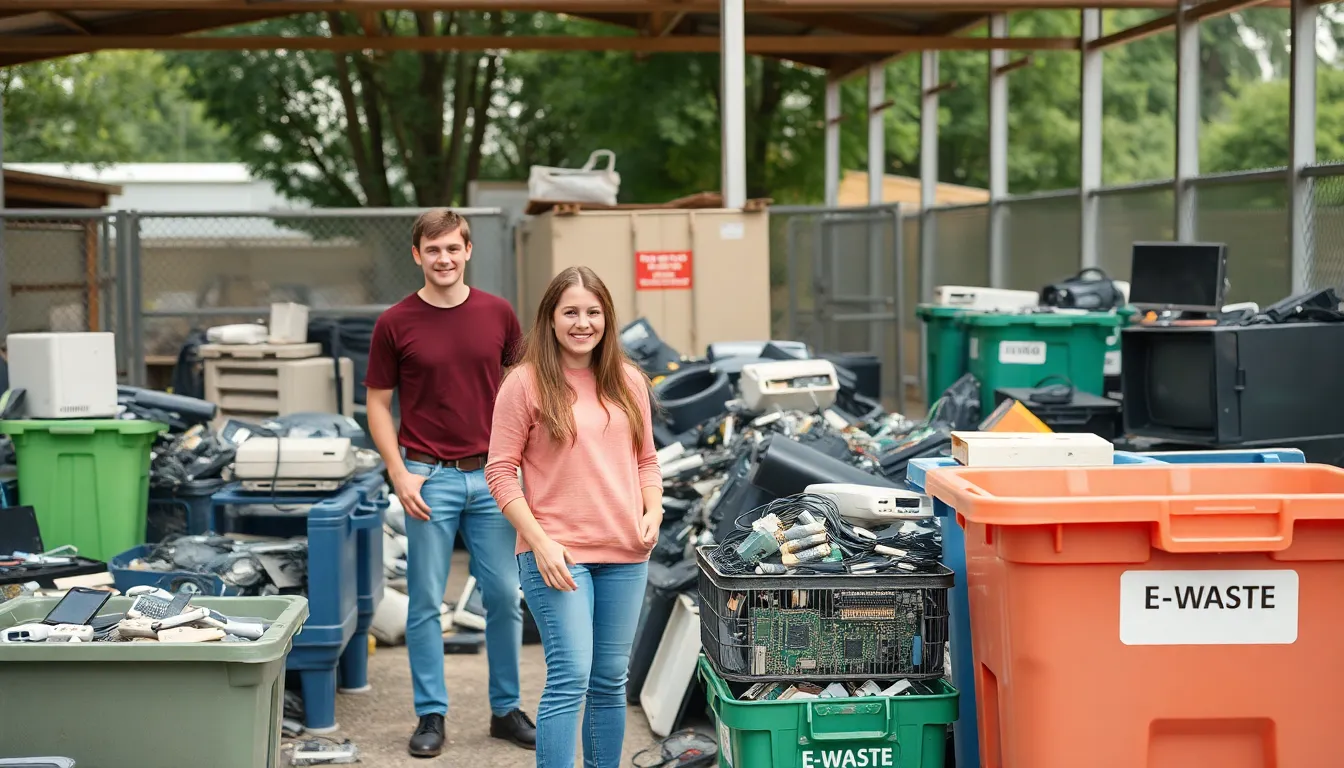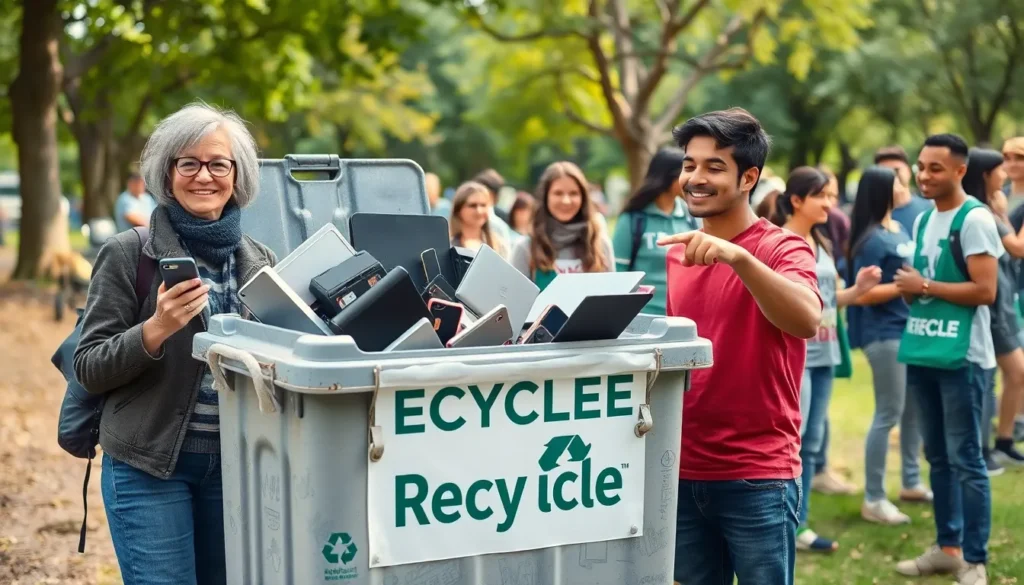In a world overflowing with gadgets, it’s easy to forget that those shiny devices have a lifespan. Tech recycling isn’t just a buzzword; it’s a superhero in disguise, swooping in to save the planet from the perils of e-waste. Imagine all those forgotten phones and outdated laptops piling up like a digital graveyard. They deserve better than a lonely existence in a landfill!
Table of Contents
ToggleOverview Of Tech Recycling
Tech recycling addresses the critical issue of e-waste by properly disposing of and reusing electronic devices. Many people discard old phones, laptops, and tablets without considering the environmental consequences. Electronic waste can release harmful substances into the environment if not managed effectively. Tech recycling programs aim to divert these devices from landfills and promote sustainable practices.
Recyclable materials often include metals, plastics, and glass found in electronics. For instance, about 63 million metric tons of e-waste were generated globally in 2019, according to the Global E-waste Monitor. This staggering amount highlights the need for efficient recycling methods. Tech recycling allows companies and individuals to recover valuable materials while reducing the demand for new resources.
Organizations providing tech recycling services offer safe collection and processing of unwanted devices. They dismantle electronics, separate materials, and ensure proper handling of hazardous components. Many businesses partner with certified recyclers to guarantee compliance with environmental regulations. It’s essential those looking to recycle their tech verify the recycling company’s credentials.
Innovative tech recycling initiatives encourage community involvement. Local events enable citizens to drop off old devices at designated collection points. By participating in these events, individuals contribute to a healthier planet while promoting responsible consumption. Tech recycling not only mitigates environmental impact but also supports the circular economy by reintroducing materials into manufacturing processes.
Technological advancements continue to enhance the efficiency of recycling processes. New methods, such as automated sorting and advanced shredding techniques, improve recovery rates of recyclable materials. The importance of tech recycling cannot be overstated, as it fosters a sustainable future and protects natural resources for generations to come.
Importance Of Tech Recycling

Tech recycling plays a critical role in mitigating the e-waste crisis that continues to escalate globally. As discarded electronic devices accumulate in landfills, the urgency to address their impacts has never been greater.
Environmental Impact
E-waste significantly contributes to environmental degradation. When electronic devices break down in landfills, they release toxic substances like lead and mercury, which contaminate soil and water sources. In 2019, the world generated about 63 million metric tons of e-waste, highlighting the scale of this issue. Unmanaged e-waste not only threatens ecosystems but also risks public health. By engaging in tech recycling, individuals and organizations can prevent harmful materials from entering the environment, promoting cleaner communities.
Resource Conservation
Tech recycling conserves finite natural resources. Many electronic devices contain valuable materials such as gold, copper, and aluminum, which can be recovered and reused. Recycling these materials reduces the need for mining and decreasing the related environmental footprint. For instance, recycling one million cell phones can extract over 24,000 pounds of gold. In addition, the process minimizes energy consumption associated with producing new devices. Utilizing recycling programs allows society to support sustainable practices while meeting the demand for essential resources.
Common Tech Products For Recycling
Many tech products contribute significantly to e-waste and should be recycled responsibly. Understanding which products to recycle supports environmental sustainability and promotes the recovery of valuable materials.
Smartphones
Smartphones rank among the most commonly discarded items due to rapid technological advancements. Approximately 1.5 billion smartphones were sold worldwide in 2021, creating substantial e-waste. Each smartphone contains precious metals like gold, silver, and copper, making recycling these devices beneficial. Recycled smartphones prevent harmful substances like lead and cadmium from leaching into the environment. They can also be refurbished, extending their life and reducing the demand for new products. Programs focused on smartphone recycling facilitate safe collection methods, ensuring responsible disposal and resource recovery.
Laptops
Laptops also contribute significantly to e-waste accumulation, with over 224 million units sold in 2020. Many laptops contain recyclable materials such as aluminum and rare earth metals. Disposing of laptops improperly can lead to environmental contamination. Recycling allows for the recovery of these materials, minimizing the need for environmentally impactful mining operations. Organizations specializing in laptop recycling dismantle components safely, separating hazardous substances from reusable parts. Proper recycling processes enable the continuous cycle of materials, supporting sustainability.
Printers
Printers are another common tech product that frequently ends up in landfills. In 2021, around 25 million printers were sold, contributing to the growing e-waste problem. Conventional printers often contain plastics, metals, and electronic components that can be recycled. Responsible recycling can reclaim valuable materials while preventing toxic chemicals from entering the environment. Many printer manufacturers offer take-back programs, ensuring that old devices are processed in an eco-friendly manner. Utilizing these services promotes the circular economy and reduces overall environmental impact.
Tech Recycling Process
The tech recycling process involves several essential steps to ensure effective e-waste management. Proper collection and sorting methods play a critical role in this process.
Collection Methods
Organizations implement various collection methods to gather unwanted electronic devices. Drop-off centers allow individuals to bring their devices to designated locations. Mobile collection events offer convenience by visiting neighborhoods, making participation easier. Partnerships with retail stores facilitate collection by providing recycling kiosks at their sites. Community programs engage local residents, encouraging them to recycle at specific times. Each method ensures that devices are collected safely and responsibly, diverting them from landfills and reducing potential environmental harm.
Refurbishment vs. Recycling
Refurbishment and recycling serve different purposes in the tech recycling process. Refurbishment involves repairing and upgrading devices for resale, extending their lifespan and ensuring usability. Many devices such as laptops and smartphones can be restored to functionality, reducing the need for new units. Recycling, on the other hand, focuses on breaking down electronic components to recover valuable materials. It involves dismantling devices and repurposing elements like metals and plastics. Both processes contribute significantly to waste reduction and resource conservation, essential for promoting environmental sustainability.
Challenges In Tech Recycling
Various challenges exist in the tech recycling landscape, impacting its effectiveness and reach. E-waste legislation plays a crucial role in shaping recycling practices. Many regions lack comprehensive regulations, creating confusion over the responsibility for e-waste disposal. Existing laws often differ significantly between countries and states, complicating enforcement. Inconsistent frameworks hinder efforts to establish standard recycling procedures. Additionally, compliance can incur costs that deter participation among businesses and individuals.
Consumer awareness also poses significant challenges. Many consumers remain unaware of the proper methods for disposing of their electronic devices. In 2021, only 17 percent of global e-waste was documented as being recycled, indicating that substantial amounts end up in landfills. Misconceptions about recycling processes lead people to believe that throwing away old electronics is acceptable. Moreover, educational efforts often struggle to reach key demographics, limiting the overall impact. Engaging consumers through targeted campaigns could foster greater awareness and encourage responsible recycling habits.
Tech recycling stands as a pivotal strategy in combating the escalating e-waste crisis. By responsibly managing old electronics, individuals and organizations can significantly reduce environmental harm and recover valuable materials. Engaging in tech recycling not only protects communities from toxic substances but also promotes resource conservation.
As technology continues to evolve, the importance of effective recycling practices will only grow. By raising awareness and supporting local recycling initiatives, everyone can play a role in fostering a sustainable future. Embracing tech recycling is not just a choice; it’s a responsibility that benefits both the planet and society as a whole.

